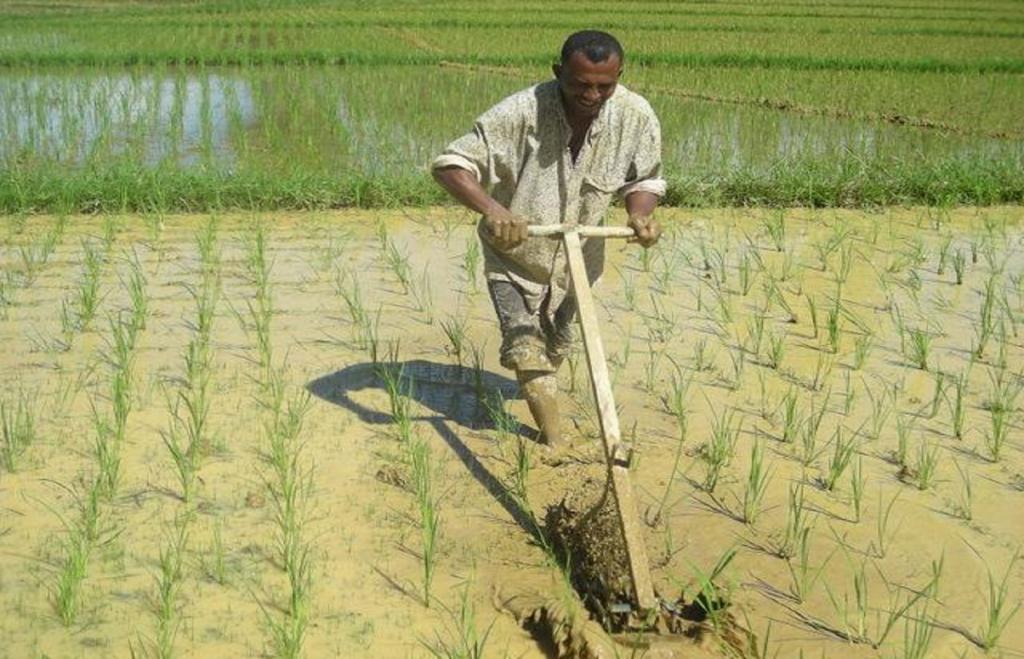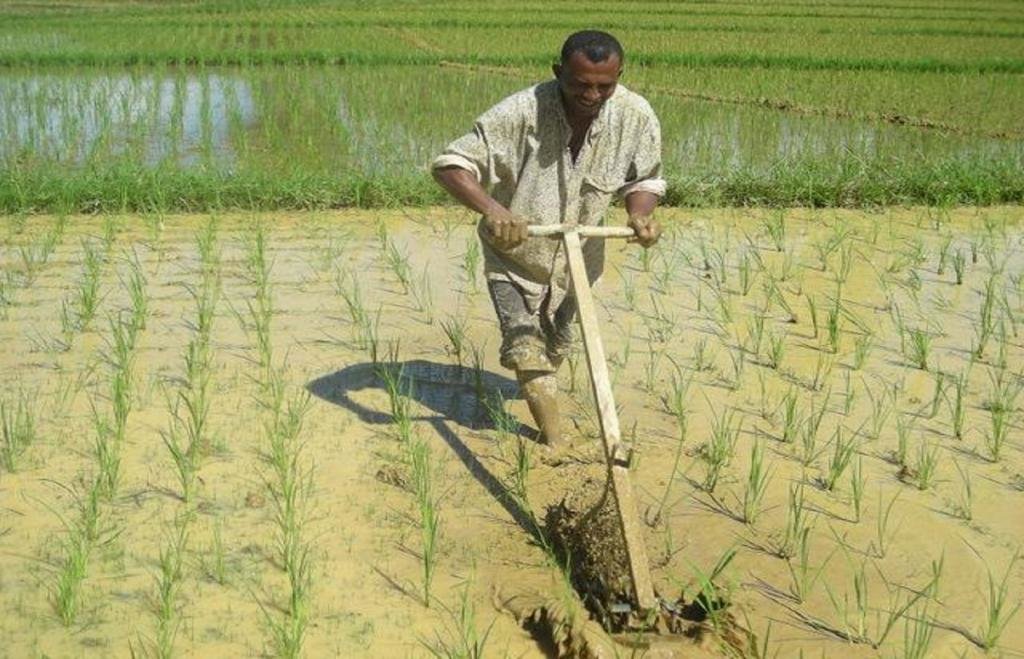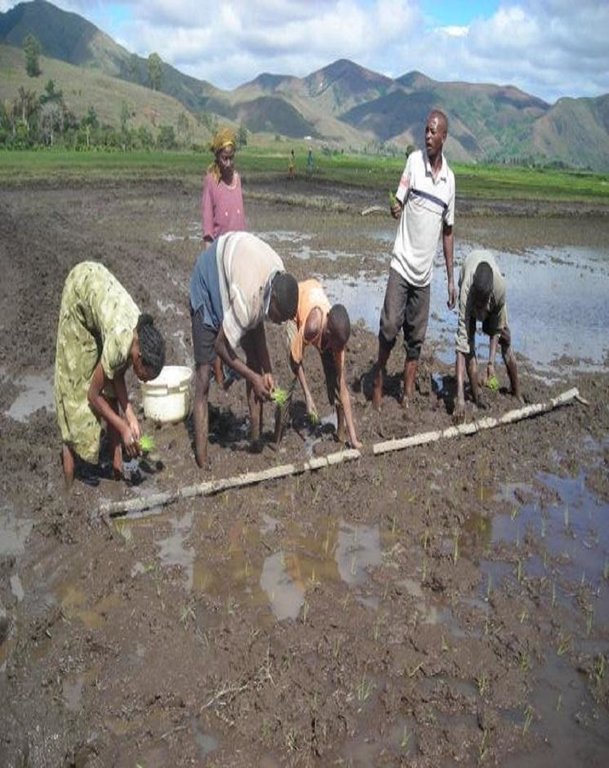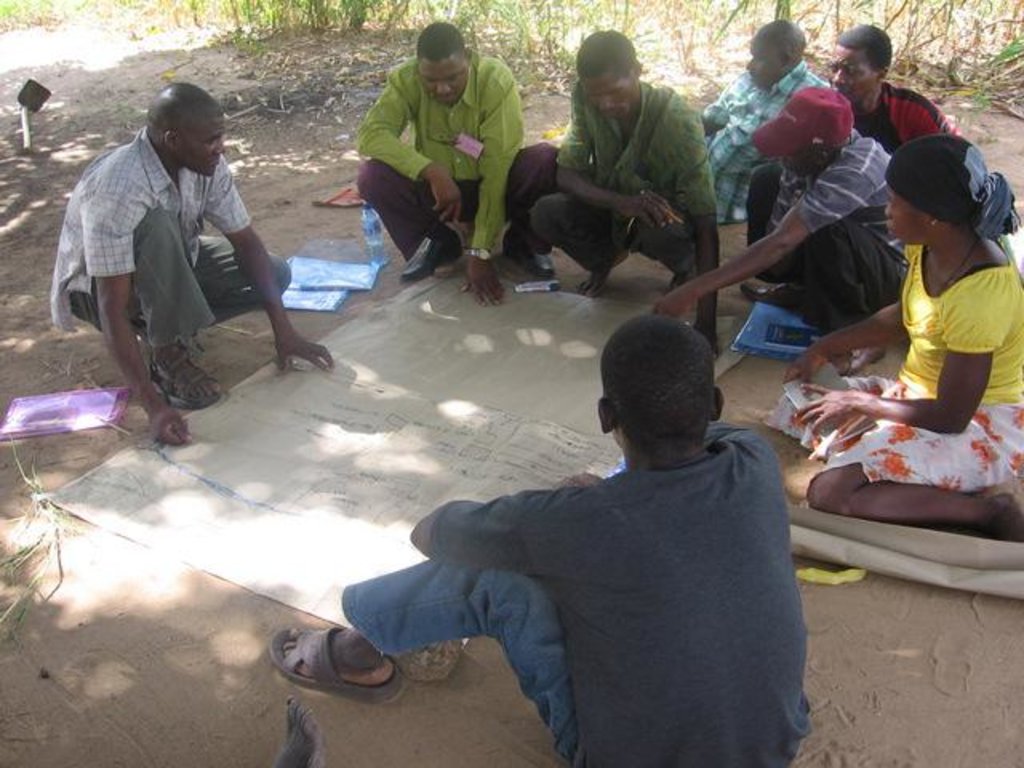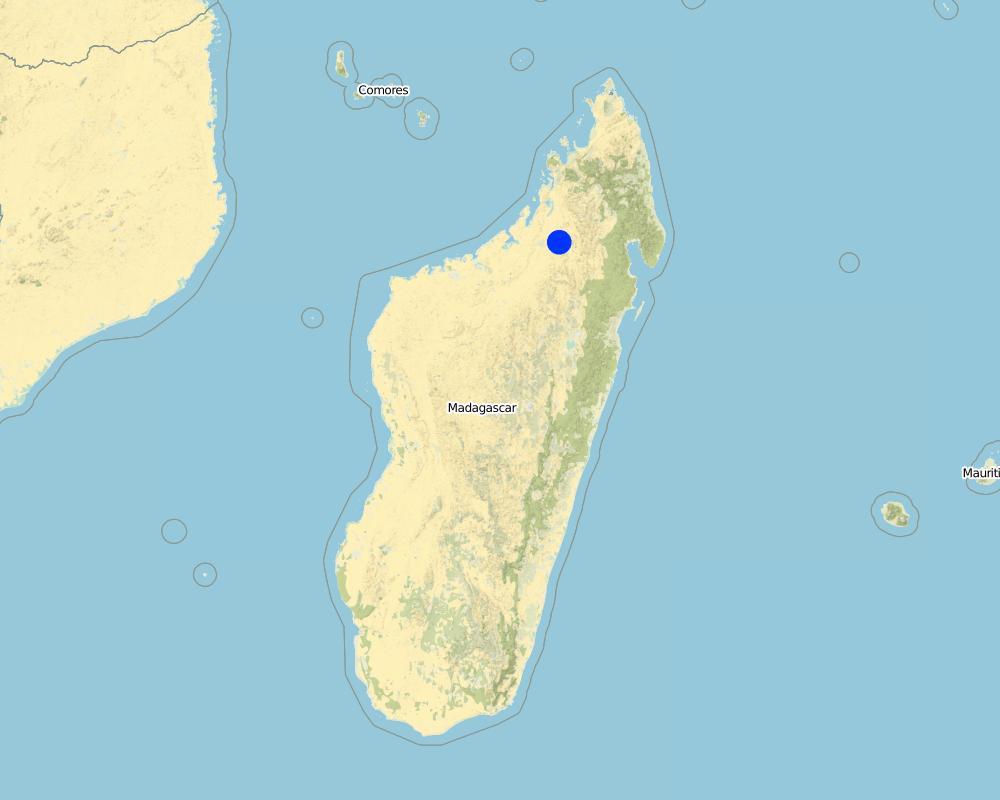Participatory Learning and Action Research approach to Integrated Rice Management [ມາດາກັສກາ]
- ການສ້າງ:
- ປັບປູງ:
- ຜູ້ສັງລວມຂໍ້ມູນ: Unknown User
- ບັນນາທິການ: –
- ຜູ້ທົບທວນຄືນ: Fabian Ottiger
approaches_2571 - ມາດາກັສກາ
ເບິ່ງພາກສ່ວນ
ຂະຫຍາຍທັງໝົດ ຍຸບທັງໝົດ1. ຂໍ້ມູນທົ່ວໄປ
1.2 ລາຍລະອຽດ ການຕິດຕໍ່ ຂອງບຸກຄົນທີ່ຊັບພະຍາກອນ ແລະ ສະຖາບັນ ການມີສ່ວນຮ່ວມ ໃນການປະເມີນຜົນ ແລະ ເອກະສານ ຂອງວິທີທາງ
Agric. R&D consultant:
Defoer Toon
tdefoer@aliceadsl.fr
Najac, France
ຝຣັ່ງ
ຜູ້ຊ່ຽວຊານ ດ້ານການຄຸ້ມຄອງ ທີ່ດິນແບບຍືນຍົງ:
Wopereis Marco
wopereis@cgiar.org.
Africa Rice Center
Cotonou
ເບນິນ
ຊື່ຂອງ ສະຖາບັນການຈັດຕັ້ງ ທີ່ອໍານວຍຄວາມສະດວກ ໃນການສ້າງເອກກະສານ ຫຼື ປະເມີນແນວທາງ (ຖ້າກ່ຽວຂ້ອງ)
CDE Centre for Development and Environment (CDE Centre for Development and Environment) - ສະວິດເຊີແລນຊື່ຂອງ ສະຖາບັນການຈັດຕັ້ງ ທີ່ອໍານວຍຄວາມສະດວກ ໃນການສ້າງເອກກະສານ ຫຼື ປະເມີນແນວທາງ (ຖ້າກ່ຽວຂ້ອງ)
Africa Rice Center (AfricaRice) - ປະເທດ Côte d'Ivoire1.3 ເງື່ອນໄຂ ຂອງການນໍາໃຊ້ເອກກະສານຂໍ້ມູນ ຂອງ WOCAT
ຜູ້ສັງລວມ ແລະ ບັນດາຜູ້ຕອບແບບສອບຖາມ ຍອມຮັບໃນເງື່ອນໄຂ ການນໍາໃຊ້ຂໍ້ມູນເອກະສານ ທີ່ສ້າງຂື້ນ ໂດຍຜ່ານ ອົງການ WOCAT:
ແມ່ນ
2. ພັນລະນາ ແນວທາງການຄຸ້ມຄອງນໍາໃຊ້ດິນແບບຍືນຍົງ
2.1 ການອະທິບາຍ ໂດຍຫຍໍ້ ຂອງວິທີທາງ
The Participatory Learning and Action Research approach to Integrated Rice Management (PLAR-IRM) is a bottom-up, social and experiential learning approach, leading to sustainable agricultural improvements, based on mutual support and communication among farmers.
2.2 ການອະທິບາຍ ລາຍລະອຽດ ຂອງວິທີທາງ
ການອະທິບາຍ ລາຍລະອຽດ ຂອງວິທີທາງ:
Aims / objectives: Innovation and agricultural change is aimed for, through capacity strengthening of all major stakeholders involved in the rice sub-sector. IRM refers to the production system and value chain as a whole. Innovation is not limited to technological change; it also includes time management and the building of social networks and institutions for mutual collaboration between farmers and other stakeholders within the rice value chain. A step-wise, self-discovery learning mode encourages the stakeholders to find solutions for their own site-specific problems. During the first years, groups of 25-30 producers are supported by a programme facilitator who animates the learning and innovation sessions. The main instruments are the learning modules dealing with specific crop management practices, harvest and post-harvest practices (involving processors and entrepreneurs also), as well as the agro-ecological and socio-economic conditions of rice production. The sessions aim to strengthen farmers’ and other rice stakeholders' capacity to observe, analyze, interpret, make decisions, innovate and share knowledge and experiences. PLAR is based on locally relevant knowledge, practices and skills. Exchanges about current practices, and their logic or justification, are the starting point in all modules.
Methods: In a learning-by-doing approach farmers are encouraged to try out any new ideas identified during PLAR sessions on some parts of their fields reserved for new practices (“innovation space”). This allows them to assess the impact of such innovations on their rice yield, or on the profitability of rice growing and the rice business as a whole, and consequently to adapt and fine-tune the measures taken according to their needs. These innovation spaces are regularly visited as part of learning sessions for knowledge sharing between farmers. Since 2005, innovations in land preparation, early transplanting of seedlings, weeds and water management - basically without external inputs - have resulted in three times higher yields, benefitting thousands of farmers. Rice value chain activities started in 2008 with a view to empowering farmers' position within the chains and improving the competitiveness. Groups are unifying into PLAR centres with common marketing of rice, and contract input providers and rice processors.
2.3 ຮູບພາບຂອງແນວທາງ
2.5 ປະເທດ / ເຂດ / ສະຖານທີ່ບ່ອນທີ່ແນວທາງໄດ້ຖືກນໍາໃຊ້
ປະເທດ:
ມາດາກັສກາ
ຂໍ້ມູນເພີ່ມເຕີມຂອງສະຖານທີ່:
Sofia Region
Map
×2.7 ປະເພດຂອງແນວທາງ
- ພາຍໃຕ້ໂຄງການ / ແຜນງານ
2.8 ເປົ້າໝາຍ / ຈຸດປະສົງຫຼັກ ຂອງການຈັດຕັ້ງປະຕິບັດ ວິທີທາງ
The Approach focused mainly on SLM with other activities (value chain develop¬ment: collective storage and marketing of rice; contractual arrangements with input providers and rice processors)
Sustainably improving food security, livelihoods and incomes of poor rice farmers by boosting the profitability of rice production and increasing the efficiency and competitiveness of the rice sub-sector; Capacity strengthening of all stake-holders involved in the rice-subsector
The SLM Approach addressed the following problems: Low yields in rice production; Most farmers live below subsistence level; Absence of government and NGO support; Limited access to markets, lack of infrastructure
3. ການມີສ່ວນຮ່ວມ ແລະ ບົດບາດຂອງພາກສ່ວນທີ່ກ່ຽວຂ້ອງທີ່ໄດ້ມີສ່ວນຮ່ວມ
3.1 ຜູ້ມີສ່ວນຮ່ວມ ໃນວິທີທາງ ແລະ ພາລະບົດບາດ ຂອງເຂົາເຈົ້າ
- ຜູ້ນໍາໃຊ້ດິນໃນທ້ອງຖິ່ນ / ຊຸມຊົນທ້ອງຖິ່ນ
rice farmers
marginalised poor rice farmers are targeted
- ພາກເອກະຊົນ
private service providers (e.g. input suppliers), rice processors and buyers
- ອໍານາດ ການປົກຄອງທ້ອງຖິ່ນ
- ອົງການຈັດຕັ້ງ ສາກົນ
Aga Khan Foundation
3.2 ການມີສ່ວນຮ່ວມຂອງຜູ້ນໍາໃຊ້ທີ່ດິນໃນທ້ອງຖິ່ນ / ຊຸມຊົນທ້ອງຖິ່ນໃນໄລຍະທີ່ແຕກຕ່າງກັນຂອງແນວທາງ
| ການລວບລວມ ເອົາຜູ້ນໍາໃຊ້ດິນ ໃນທ້ອງຖິ່ນ / ຊຸມຊົນທ້ອງຖິ່ນ | ໃຫ້ລະບຸ ຜູ້ໃດທີ່ມີສ່ວນຮ່ວມ ໃນແຕ່ລະກິດຈະກໍາ? | |
|---|---|---|
| ການເລີ່ມຕົ້ນ / ແຮງຈູງໃຈ | ການຮ່ວມມື | |
| ການວາງແຜນ | ການຮ່ວມມື | |
| ການປະຕິບັດ | ການຮ່ວມມື | |
| ຕິດຕາມກວດກາ / ການປະເມີນຜົນ | ບໍ່ມີ | |
| Research | ບໍ່ມີ |
3.4 ການຕັດສິນໃຈກ່ຽວກັບການຄັດເລືອກເຕັກໂນໂລຢີຂອງການຄຸ້ມຄອງທີ່ດິນແບບຍືນຍົງ / ເຕັກໂນໂລຢີ
ລະບຸ ຄົນທີ່ຕັດສິນໃຈ ກ່ຽວກັບການຄັດເລືອກຂອງ ເຕັກໂນໂລຢີ / ເຕັກໂນໂລຢີ ຈະໄດ້ຮັບການປະຕິບັດ:
- ຜູ້ນໍາໃຊ້ດິນຜູ້ດຽວ (ການລິເລີ່ມດ້ວຍຕົນເອງ)
ອະທິບາຍ:
Decisions on the method of implementing the SLM Technology were made by mainly by land users supported by SLM specialists
4. ການສະໜັບສະໜູນທາງດ້ານວິຊາການ, ການສ້າງຄວາມສາມາດ, ແລະ ການຈັດການຄວາມຮູ້.
4.1 ການສ້າງຄວາມສາມາດ / ການຝຶກອົບຮົມ
ຜູ້ນໍາໃຊ້ທີ່ດິນ ຫຼື ພາກສ່ວນກ່ຽວຂ້ອງອື່ນໆ ໄດ້ຮັບການຝຶກອົບຮົມບໍ່?
ແມ່ນ
ໃຫ້ລະບຸ ຜູ້ໃດທີ່ໄດ້ຮັບການຝຶກອົບຮົມ:
- ຜູ້ນໍາໃຊ້ດິນ
- ພະນັກງານພາກສະໜາມ / ທີ່ປຶກສາ
ຮູບແບບຂອງການຝຶກອົບຮົມ:
- ການເຮັດຕົວຈິງ
- ຕົວຕໍ່ຕົວ
ໃນຫົວຂໍ້:
crop management practices, harvest and post-harvest practices (incl. storage, marketing), socio-economic and ecological conditions of rice farming; curriculum based on needs assessment
4.2 ການບໍລິການໃຫ້ຄໍາປຶກສາ
ເຮັດຜູ້ໃຊ້ທີ່ດິນມີການເຂົ້າເຖິງການບໍລິການໃຫ້ຄໍາປຶກສາ?
ແມ່ນ
ລະບຸວ່າການສະໜອງ ການບໍລິການ ໃຫ້ຄໍາປຶກສາ:
- ໃນພື້ນທີ່ຂອງຜູ້ນໍາໃຊ້ດິນ
ອະທິບາຍ / ຄວາມຄິດເຫັນ:
Name of method used for advisory service: modular learning sessions guided by a facilitator, farmer-to-farmer extension; Approach is based on indigenous knowledge
4.5 ການຄົ້ນຄວ້າ
ນີ້້ແມ່ນສ່ວນໜຶ່ງ ການຄົ້ນຄວ້າ ຂອງວິທີທາງບໍ່?
ແມ່ນ
ໃຫ້ຂໍ້ມູນ ເພີ່ມເຕີມ ແລະ ກໍານົດ ຜູ້ໃດເຮັດການຄົ້ນຄວ້າ:
crop management practices
Research was carried out on-farm
5. ການສະໜັບສະໜູນທາງດ້ານການເງິນ ແລະ ອຸປະກອນຈາກພາຍນອກ
5.1 ງົບປະມານປະຈໍາປີ ສໍາລັບວິທີທາງ ຂອງການຄຸ້ມຄອງ ທີ່ດິນແບບຍືນຍົງ
ຖ້າຫາກບໍ່ຮູ້ຈັດງົບປະມານທີ່ແນ່ນອນ ແມ່ນໃຫ້ປະມານເອົາ:
- 100,000-1,000,000
ຄໍາເຫັນ (ຕົວຢ່າງ: ແຫຼ່ງຂໍ້ມູນຫຼັກ ຂອງການສະໜອງທຶນ / ຜູ້ໃຫ້ທຶນທີ່ສໍາຄັນ):
Approach costs were met by the following donors: international: 10.0%; national non-government: 30.0%; private sector: 10.0%; local community / land user(s): 50.0%
5.2 ການສະໜັບສະໜູນ ທາງດ້ານການເງິນ / ອຸປະກອນ ສະໜອງໃຫ້ແກ່ຜູ້ນໍາທີ່ດິນ
ຜູ້ນໍາໃຊ້ດິນ ໄດ້ຮັບການສະໜັບສະໜູນ ທາງດ້ານ ການເງິນ / ອຸປະກອນ ໃນການຈັດຕັ້ງປະຕິບັດ ເຕັກໂນໂລຢີບໍ?
ແມ່ນ
5.3 ເງິນສົມທົບສໍາລັບການນໍາໃຊ້ສະເພາະປັດໃຈຂາເຂົ້າໃນການຜະລີດກະສິກໍາ (ລວມທັງແຮງງານ)
- ອຸປະກອນ
| ໃຫ້ລະບຸໄດ້ຮັບການສະໜັບສະໜູນປັດໃຈຂາເຂົ້າຫຍັງແດ່ | ທີ່ຂອບເຂດ | ລະບຸ ການອຸດໜູນ |
|---|---|---|
| ເຄື່ອງມື | ງົບປະມານເຕັມສ່ວນ | Two sarcleuses (weeding equipment) per starting group are provided for free and remain property of the group |
ຄວາມຄິດເຫັນ:
Two sarcleuses (weeding equipment) per starting group are provided for free and remain property of the group
5.4 ສິນເຊື່ອ
ໄດ້ປ່ອຍສິນເຊື່ອ ສະໜອງໃຫ້ພາຍໃຕ້ ວິທີການສໍາລັບກິດຈະກໍາ ການຄຸ້ມຄອງ ທີ່ດິນແບບຍືນນຍົງບໍ່?
ແມ່ນ
ເງື່ອນໄຂກໍານົດ (ອັດຕາດອກເບ້ຍ, ຈ່າຍຄືນ, ແລະ ອື່ນໆ) :
Interest rate charged: 2.5%; repayment conditions: Was supported by the approach in collaboration with an existing microfinance institution; loan period: 6-8 months, 2.5% monthly (!) interest rate.
6. ວິເຄາະຜົນກະທົບ ແລະ ສັງລວມບັນຫາ
6.1 ຜົນກະທົບຂອງແນວທາງ
ການຈັດຕັ້ງປະຕິບັດ ວິທີທາງ ສາມາດຊ່ວຍຜູ້ນໍາໃຊ້ທີ່ດິນ ໃນການຈັດຕັ້ງປະຕິບັດ ແລະ ບໍາລຸງຮັກສາ ເຕັກໂນໂລຢີ ການຄຸ້ມຄອງ ທີ່ດິນແບບຍືນຍົງໄດ້ບໍ?
- ບໍ່
- ມີ, ໜ້ອຍໜຶ່ງ
- ມີ, ພໍສົມຄວນ
- ມີ, ຫຼາຍ
yields have increased by > 200% (on innovation spaces)
ການຈັດຕັ້ງປະຕິບັດ ວິທີທາງ ສາມາດສ້າງຄວາມເຂັ້ມແຂງ ທາງສັງຄົມ ແລະ ເສດຖະກິດບໍ່?
- ບໍ່
- ມີ, ໜ້ອຍໜຶ່ງ
- ມີ, ພໍສົມຄວນ
- ມີ, ຫຼາຍ
marginalised poor rice farmers are targeted
Did other land users / projects adopt the Approach?
- ບໍ່
- ມີ, ໜ້ອຍໜຶ່ງ
- ມີ, ພໍສົມຄວນ
- ມີ, ຫຼາຍ
from 2005-2009 PLAR groups have increased from 6 up to 102, involving 3782 families and extended to 4200 non grouped farmers
Did the Approach help to alleviate poverty?
- ບໍ່
- ມີ, ໜ້ອຍໜຶ່ງ
- ມີ, ພໍສົມຄວນ
- ມີ, ຫຼາຍ
SLM practices result into a net benefit of > 700 US$/ha
6.2 ແຮງຈູງໃຈຫຼັກຂອງຜູ້ນໍາໃຊ້ທີ່ດິນໃນການປະຕິບັດການຄຸ້ມຄອງທີ່ດິນແບບຍືນຍົງ
- ການຜະລິດເພີ່ມຂຶ້ນ
- ກໍາໄລເພີ່ມຂຶ້ນ (ຄວາມສາມາດ), ການປັບປຸງຄ່າໃຊ້ຈ່າຍ, ຜົນປະໂຫຍດ, ອັດຕາສ່ວນ
- ລວມເຂົ້ານໍາກັນກັບການເຄື່ອນໄຫວ / ໂຄງການ / ກຸ່ມ / ເຄືອຂ່າຍ
6.3 ຄວາມຍືນຍົງຂອງກິດຈະກໍາວິທີທາງ
ຜູ້ນໍາໃຊ້ ທີ່ດິນ ສາມາດສືບຕໍ່ ການຈັດຕັ້ງປະຕິບັດ ຜ່ານວິທີທາງໄດ້ບໍ່ (ໂດຍປາດສະຈາກ ການຊ່ວຍເຫຼືອ ຈາກພາກສ່ວນພາຍນອກ)?
- ແມ່ນ
ຖ້າ ໄດ້, ອະທິບາຍເຫດຜົນ:
In a 2nd phase farmers who are organised in PLAR groups gradually build up the capacity to manage the innovation and mutual learning approach on their own without programme support: Farmers facilitators are trained to take over the lead of PLAR groups with backstopping from programme facilitators.
6.4 ຈຸດແຂງ / ຂໍ້ດີ ຂອງວິທີທາງ
| ຈຸດແຂງ / ຈຸດດີ / ໂອກາດ ຈາກທັດສະນະຂອງຜູ້ປ້ອນຂໍ້ມູນ ຫຼື ບຸກຄົນສຳຄັນ |
|---|
| Farmers learn basic principles of rice management and develop their own locally adapted options for improvements; the innovation comes from inside the groups. |
| Farmers build up individual and organisational capacity to find solutions to their problems and build confidence as efficient partners with other value chain actors. |
6.5 ຈຸດອ່ອນ / ຂໍ້ເສຍຂອງແນວທາງ ແລະ ວິທີການແກ້ໄຂໃຫ້ເຂົາເຈົ້າ
| ຈຸດອ່ອນ ຫຼື ຂໍ້ເສຍ ຫຼື ຄວາມສ່ຽງ ໃນມຸມມອງຂອງ ຜູ້ສັງລວມຂໍ້ມູນ ຫຼື ບັນດາຜູ້ຕອບແບບສອບຖາມ | ມີວິທີການແກ້ໄຂຄືແນວໃດ? |
|---|---|
| Labour intensive improvements | provision of group credit to PLAR group members in collaboration with a local microfinance institution |
| Learning intensive approach, with regular group learning sessions | PLAR groups elaborate their own learning programmes and curricula according to their availability and needs |
7. ເອກກະສານອ້າງອີງ ແລະ ຂໍ້ມູນການເຊື່ອມໂຍງ
7.1 ວິທີການ / ແຫຼ່ງຂໍ້ມູນ
- ການໄປຢ້ຽມຢາມພາກສະໜາມ, ການສໍາຫຼວດພາກສະໜາມ
- ການສໍາພາດ ຜູ້ນໍາໃຊ້ທີ່ດິນ
7.2 ເອກະສານທົ່ວໄປທີ່ສາມາດໃຊ້ໄດ້
ຫົວຂໍ້, ຜູ້ຂຽນ, ປີ, ISBN:
Defoer T., M. Wopereis, S. Diack, and P. Idinoba. 2008. Apprentissage participatif et recherche action pour la gestion intégrée du riz à Madagascar: Manuel du facilitateur AKF, Genève, Suisse. Defoer T., M. Wopereis, P. Idinoba T. and Kadisha. 2006. Participatory Learning and Action Reseaerch (PLAR) for Integrated Rice Management in inland valleys in sub-saharan Africa: Facilitators’ manual. WARDA- the Africa Rcie Center, Bouaké, Côte d’Ivoire.
ຫົວຂໍ້, ຜູ້ຂຽນ, ປີ, ISBN:
Defoer T., M. Wopereis, P. Idinoba T. and Kadisha. 2006. Participatory Learning and Action Reseaerch (PLAR) for Integrated Rice Management in inland valleys in sub-saharan Africa: Facilitators’ manual. WARDA- the Africa Rcie Center, Bouaké, Côte d’Ivoire.
ຂໍ້ມູນການເຊື່ອມຕໍ່ ແລະ ເນື້ອໃນ
ຂະຫຍາຍທັງໝົດ ຍຸບທັງໝົດການເຊື່ອມຕໍ່
ບໍ່ມີຂໍ້ມູນການເຊື່ອມຕໍ່
ເນື້ອໃນ
ບໍ່ມີເນື້ອໃນ


